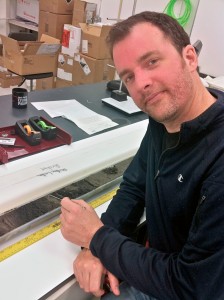–‘”˚…Á researchers eye Sikuliaq science possibilities
May 18, 2011

907-322-8730
5/17/11
Sam VanLaningham can’t wait to take the Sikuliaq for a spin.
When it’s ready for science operations in 2014, the 261-foot research vessel will be capable of drilling Bering Strait seafloor cores in any season. VanLaningham hopes those cores will uncover mysteries about the history of climate change in Alaska.
Last week, VanLaningham and several –‘”˚…Á scientists met with other researchers and agency representatives at the first Sikuliaq Science Workshop at Marinette Marine Corporation in Marinette, Wis. At the workshop, scientists presented and discussed some of the many scientific projects possible on the R/V Sikuliaq. The scientists also toured full-scale mock-ups of the vessel‚Äôs laboratories and bridge.
VanLaningham, an assistant professor of geological oceanography and an expert in paleoceanography, is particularly interested in using the Sikuliaq to collect sediment cores for his studies of how sea level changes at the Bering Strait have affected past climate in the northern hemisphere.
“We will be able to use the ship, winter or summer, to core in the Bering Strait to extract the geologic history of change at Bering Strait, and thus address its role on global climate through time,” said VanLaningham.
VanLaningham says he and other geological oceanographers are particularly excited by the large back deck of the vessel, which will allow them to collect of sediment cores up to 70 feet long.
Terry Whitledge, professor of chemical oceanography and the principal investigator for the Sikuliaq project, says the ship will be able to take scientists to areas they have never been before. He also says that the ship will be the most capable in the United States academic fleet.
“With an ice-capable ship making its home in Alaska, we are situated better than ever to address arctic questions that have global implications,” added VanLaningham.
Whitledge says that the Sikuliaq Science Workshop was infused with enthusiasm about the ship‚Äôs many capabilities and that –‘”˚…Á scientists at the workshop said that they ‚Äúcan‚Äôt wait for the big splash‚Äù‚Äîwhen the ship is launched into the Great Lakes Waterway in June 2012.
In addition to many other projects, Whitledge hopes to use the ship to explore the biology and geology of four different submarine canyons in Alaska waters: one in the Arctic, two in the Bering Sea and one in the Aleutians. Whitledge says the Sikuliaq’s advanced mapping capabilities could help determine where remotely operated vehicles and submersibles could be launched to explore these deep canyons.
Other –‘”˚…Á scientists at the workshop, including Mark Johnson, Peter Winsor, Tom Weingartner, Dean Stockwell and Seth Danielson, discussed using the ship for other projects, including surveying sea ice thickness, looking at freshwater flow into the Bering Sea from the Yukon and Kuskokwim Rivers and mapping currents in the Gulf of Alaska.
The R/V Sikuliaq, pronounced , will be an oceanographic research ship capable of bringing scientists from around the world to the icy waters of Alaska and the polar regions. The ship‚Äôs homeport will be at –‘”˚…Á‚Äôs Seward Marine Center.
The Sikuliaq project, with more than $200 million in funding from the National Science Foundation, is the largest funded project ever managed by –‘”˚…Á.
The first proposals to include ship time for the Sikuliaq will be submitted in August and October of this year. The next Sikuliaq Science Workshop will take place in February 2012 in conjunction with the American Geophysical Union’s Ocean Sciences Meeting in Salt Lake City, Utah.
The vessel will be owned by NSF and operated by –‘”˚…Á. The ship will be ready for unrestricted science operations in 2014.
About SFOS
The School of Fisheries and Ocean Sciences conducts world-class marine and fisheries research, education and outreach across Alaska, the Arctic and Antarctic. 60 faculty scientists and 150 students are engaged in building knowledge about Alaska and the world's coastal and marine ecosystems. SFOS is headquartered at the University of Alaska Fairbanks, and serves the state from facilities located in Seward, Juneau, Anchorage and Kodiak.
ADDITIONAL CONTACTS: Sam VanLaningham, assistant professor of geological oceanography, 907-474-6991 or via email at svanlaningham@alaska.edu. Terry Whitledge, professor of chemical oceanography, 907-474-7229, or via email at terry@ims.uaf.edu.
ON THE WEB:
CS/5-17-11/233-11


